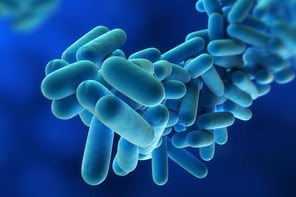Due to their complex design and often considerable size, hospital water systems can harbour a multitude of pathogens and microorganisms. Amongst the most common in healthcare water systems are gram-negative bacteria such as Legionella, with other lesser known organisms such as Mycobacteria. Fungi and mould may also be present, if less abundant.
Water Safety Groups [WSG] need to be aware of the multiple water hygiene threats that could potentially colonise their water systems and result in dangerous bacterial outbreaks amongst vulnerable populations.
Where there is a foreseeable risk from any waterborne pathogens, then a suitable action plan including appropriate control measures must be put into place via the Water Safety Plan [WSP] and the WSG.
HTM04-01 provides a limited overview of possible potential waterborne pathogens, though whether this is adequate could be debated as the focus remains primarily on Legionella and Pseudomonas aeruginosa.
Pathogens found within hospital water systems are highlighted as follows.
Legionella in Hospitals
Legionella remains the most well-known bacteria present in healthcare water systems due to media attention and ongoing management practices over many years. There are now some 70 species identified.
 Significant Legionella contamination of a water system can result in people contracting Legionnaires’ disease [LD] - a form of atypical acute pneumonia. LD results in fever, muscle pain, and nausea and can cause death if left untreated in the worst cases.
Significant Legionella contamination of a water system can result in people contracting Legionnaires’ disease [LD] - a form of atypical acute pneumonia. LD results in fever, muscle pain, and nausea and can cause death if left untreated in the worst cases.
Risks are dependent upon a combination of factors including:
- The bacteria being present in sufficient numbers;
- Suitable conditions i.e., temperatures between 20°C and 45°C;
- A source of nutrients i.e., scale, corrosion etc;
- A means of disseminating aerosols;
- And significantly in healthcare sites, the presence of vulnerable people who have compromised immune or respiratory systems or other factors i.e., smoking increases their susceptibility to Legionella infection.
Legionella Guidance - What you need to know
Comprehensive guidance is present in the form of ACoP L8 and the associated HSG274 publications particularly HTM04-01, last updated in 2016.
HTM04-01 is comprised of 4 Parts:
- Part A - Design, Installation and Commissioning;
- Part B - Operational Management;
- Part C – Pseudomonas aeruginosa, advice for augmented care units;
- Supplement Performance Specification D 08: thermostatic mixing valves (healthcare premises).
Pseudomonas aeruginosa
In the UK the role of water in the transmission of Pseudomonas aeruginosa has come under particular scrutiny following the death of one infant in Londonderry and three infants in a Belfast hospital in 2012.
 It has the potential to cause severe infections, especially in patients compromised by an underlying disease, age, or immune deficiency. i.e., the augmented care wards found within many healthcare sites. P. aeruginosa has also shown resistance to antibiotics and has virulence which means it can thrive in varying environments and with varying levels of nutrients.
It has the potential to cause severe infections, especially in patients compromised by an underlying disease, age, or immune deficiency. i.e., the augmented care wards found within many healthcare sites. P. aeruginosa has also shown resistance to antibiotics and has virulence which means it can thrive in varying environments and with varying levels of nutrients.
Unlike Legionella, where the source of the bacteria i.e., the incoming water supply, is clear, the origin of P.aeruginosa may be:
- Via the water system, particularly within the last two metres of pipe work before the point of discharge;
- Via the end user coming into contact with the outlet, following washing hands in contaminated water;
- From surfaces contaminated with water;
- From contaminated equipment.
Given this variety, the challenge for the Water Safety Group [WSG] and Infection Prevention and Control teams [IPC] is to risk-assess operational practices to minimise contamination from any of these potential sources. This can now be addressed using BS 8580-2:2022 Water quality. Risk assessments for Pseudomonas aeruginosa and other waterborne pathogens. Code of practice.
HTM04-01 Part C published in 2016, also addresses P.aeruginosa in augmented care settings and stresses the importance of the WSG and WSP in the routine management of this pathogen.
Stenotrophomonas maltophilia
Stenotrophomonas infections have been associated with disease and mortality in severely immunocompromised individuals. Whilst S. maltophilia is not a virulent organism, it is naturally resistant to many broad-spectrum antibiotics. Vulnerable groups associated with S. maltophilia infection include those with HIV infection, malignancy, cystic fibrosis, neutropenia, mechanical ventilation, central venous catheters, recent surgery, trauma, prolonged hospitalisation, and prolonged broad-spectrum antibiotic use. Robust infection control procedures will ensure the spreading of the pathogen is adequately controlled.
Mycobacterium chimaera
Infection with Mycobacteria is very rare but can be fatal and these outbreaks usually involve sternal wound infections, plastic-surgery wound infections, or post-injection abscesses, but also in patients undergoing dialysis treatment. There are also significant concerns relating to contaminated heater-cooler units [HCU] used in theatres during cardiothoracic surgery.
The HCU function is to regulate the temperature of the blood perfusing the patient using water in the HCU tanks to indirectly raise or lower the patient’s body temperature. Whilst there have been no reported NHS cases since 2015, HCUs must be operated and decontaminated according to the manufacturer’s instructions, and in conjunction with a risk assessment approved by the WSG and IPC team.
Other pathogens of concern in hospital water systems
 Waterborne outbreaks or clusters have also been seen in recent years throughout Europe for a multitude of pathogens, including Rotavirus, Cryptosporidium, Norovirus, Campylobacter, Giardia, and others. Written guidance within the UK may be limited to infection control practices and lesser-known bacteria are not typically discussed within water hygiene forums, however, your IPC lead can best advise on controlling the potential proliferation and spread of these pathogens.
Waterborne outbreaks or clusters have also been seen in recent years throughout Europe for a multitude of pathogens, including Rotavirus, Cryptosporidium, Norovirus, Campylobacter, Giardia, and others. Written guidance within the UK may be limited to infection control practices and lesser-known bacteria are not typically discussed within water hygiene forums, however, your IPC lead can best advise on controlling the potential proliferation and spread of these pathogens.
Conclusion
WSGs have many factors to consider when addressing water hygiene in their buildings, and issues and responsibilities relating to less well-known waterborne pathogens are perhaps not yet fully understood. We should, however, be optimistic in dealing with the myriad of other bacteria that inhabit our water systems.
Great strides continue to be made in the management of Legionella and P. aeruginosa and our findings should be used to aid the development of robust methods and useable guidance in the risk minimisation of ‘other bacteria’ within our water systems.
What is a Legionella risk assessment?>
Feel free to reach out if you have any questions about this blog or if you would like to consult with one of our experts for further advice on water hygiene.
Editors Note: The information provided in this blog is correct at the date of original publication - August 2022. (Revised February 2024).
© Water Hygiene Centre 2024









